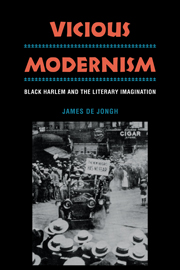Book contents
- Frontmatter
- Contents
- Acknowledgments
- Introduction: Vicious Modernism
- I The Legendary Capital: The 1920s and 1930s
- II The Emerging Ghetto: The 1940s and 1950s
- III The Inner City: The 1960s and 1970s
- Epilogue: Black Harlem and the Literary Imagination
- Appendix 1 A Checklist of Black Harlem in Poetry
- Appendix 2 A Checklist of Black Harlem in Novels
- Notes
- Index
Introduction: Vicious Modernism
Published online by Cambridge University Press: 05 February 2012
- Frontmatter
- Contents
- Acknowledgments
- Introduction: Vicious Modernism
- I The Legendary Capital: The 1920s and 1930s
- II The Emerging Ghetto: The 1940s and 1950s
- III The Inner City: The 1960s and 1970s
- Epilogue: Black Harlem and the Literary Imagination
- Appendix 1 A Checklist of Black Harlem in Poetry
- Appendix 2 A Checklist of Black Harlem in Novels
- Notes
- Index
Summary
What writers have made of Harlem is a fascinating question, for in literature, as in other fields, black Harlem quickly became a familiar feature of the landscape of the modern imagination. In Harlem, black New Yorkers had performed an epic deed by seizing a desired territory in the face of extraordinary obstacles and creating a black city that, in the years following World War I, promised to be the cultural capital of the race. Ever since, the idea of Harlem has inspired a great many writers, black and non-black alike, in a remarkably large number of works. After each of the race riots of 1919, 1943, and 1964 in American cities with large black populations, a new international generation of Africana writers – authors of African descent and heritage but writing in modern European languages (usually English, French, Spanish or Portuguese) – emerged throughout the black world, employing the Harlem motif as the emblem of an ethos of racial renewal. Many non-black authors also celebrated the city-within-a-city north of Central Park, for the idea of Harlem has come to be part of the figurative geography of modern writers of all races.
Why does the idea of Harlem so pique and intrigue the literary imagination? Harlem has been a singular icon of the twentieth-century confrontation with inherited but unacceptable understandings of race predicted by W. E. B. Du Bois in The Souls of Black Folks (1903): “The problem of the twentieth century is the problem of the color line, – the relation of the darker to the lighter races of men in Asia, Africa and the islands of the sea.”
- Type
- Chapter
- Information
- Vicious ModernismBlack Harlem and the Literary Imagination, pp. 1 - 2Publisher: Cambridge University PressPrint publication year: 1990



